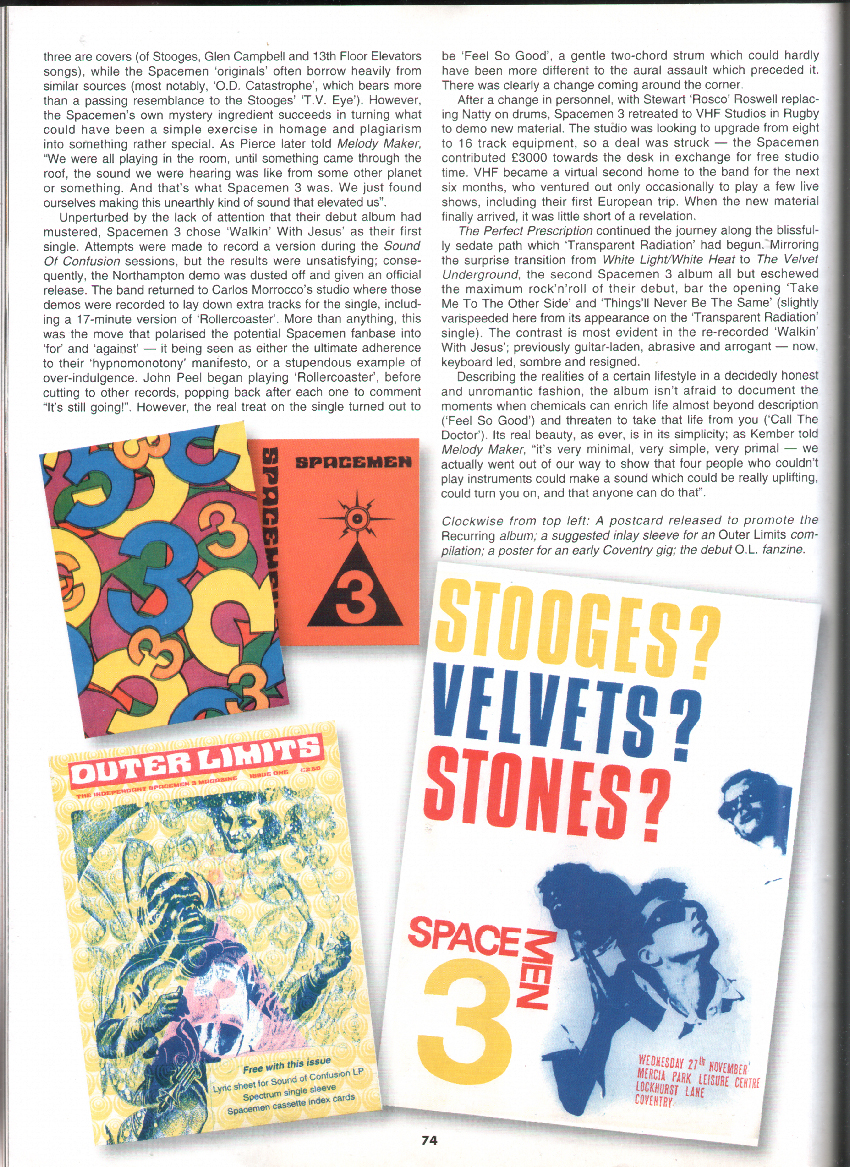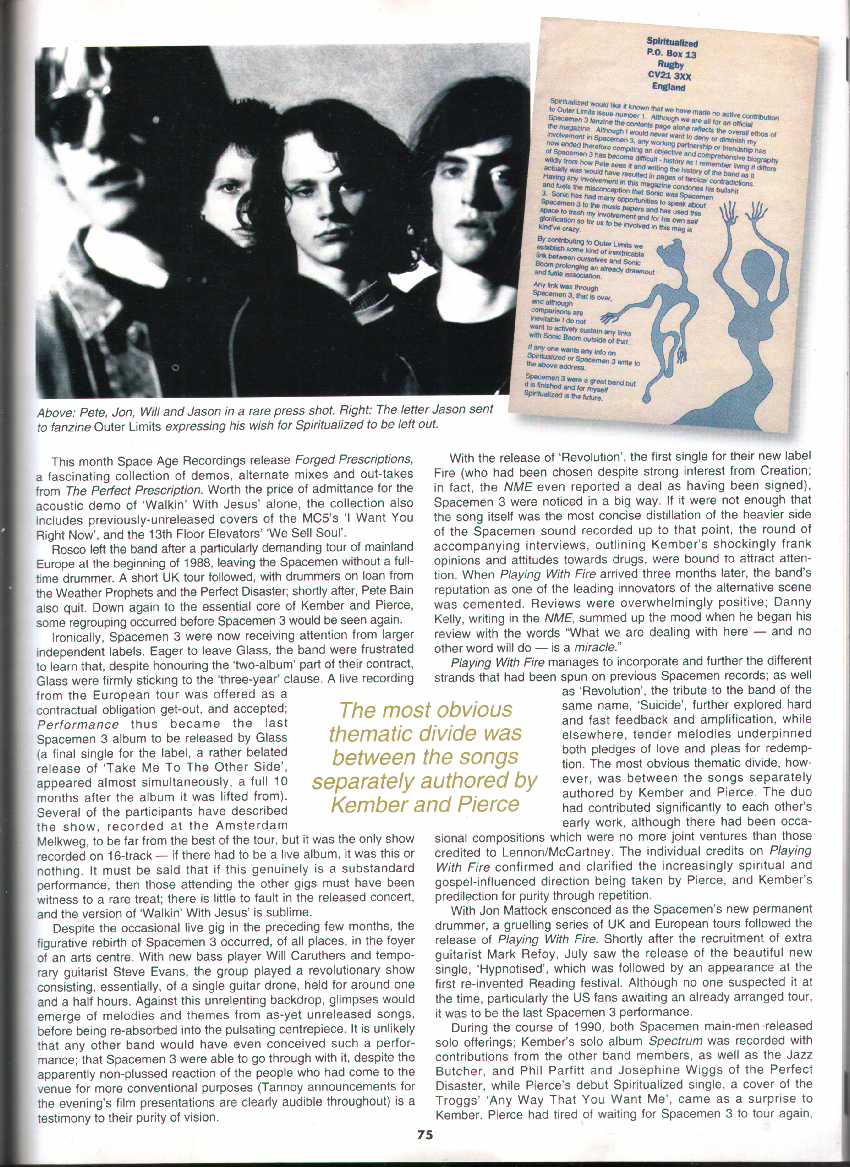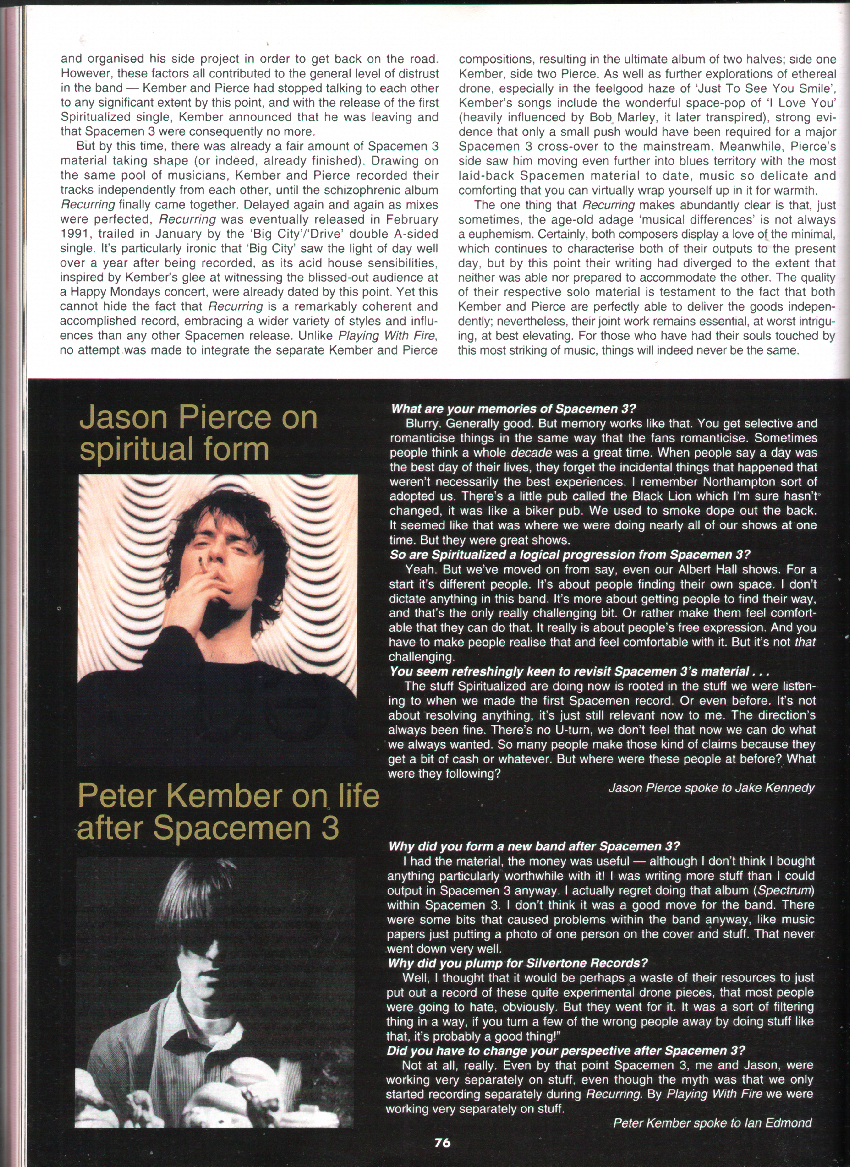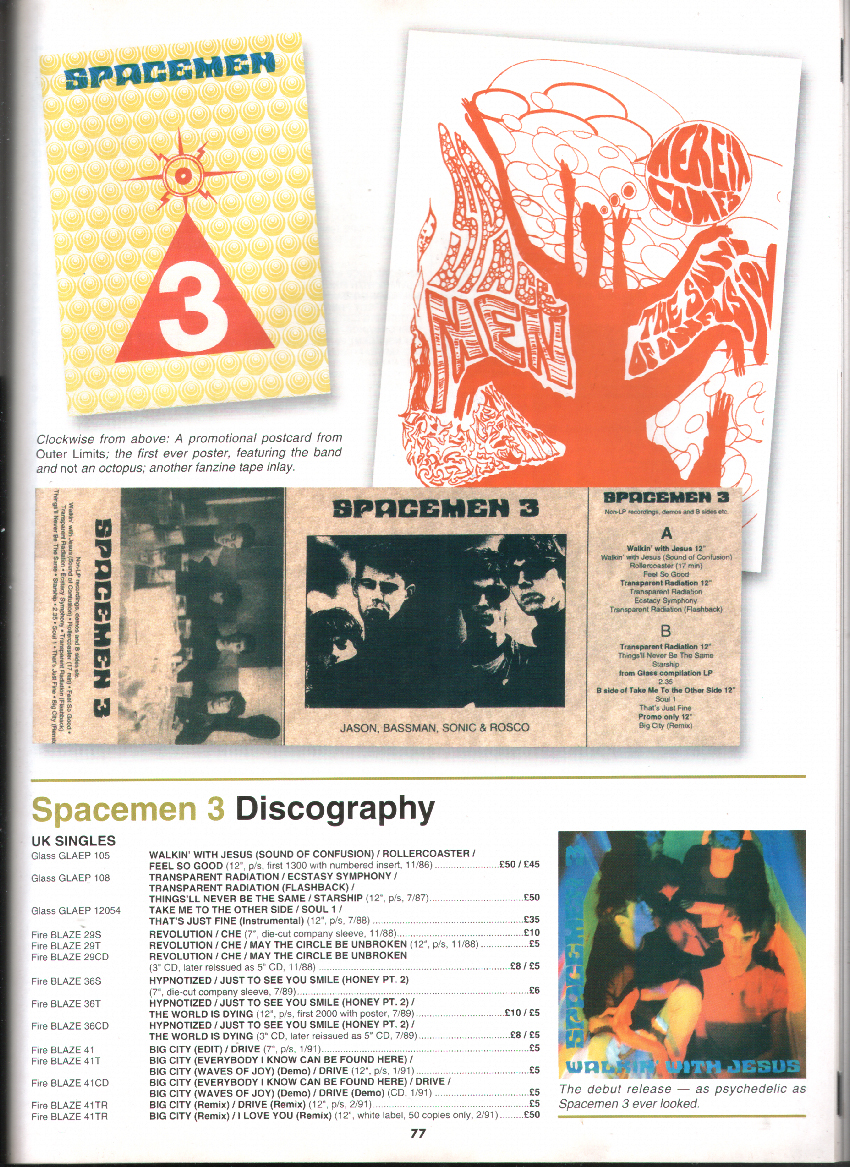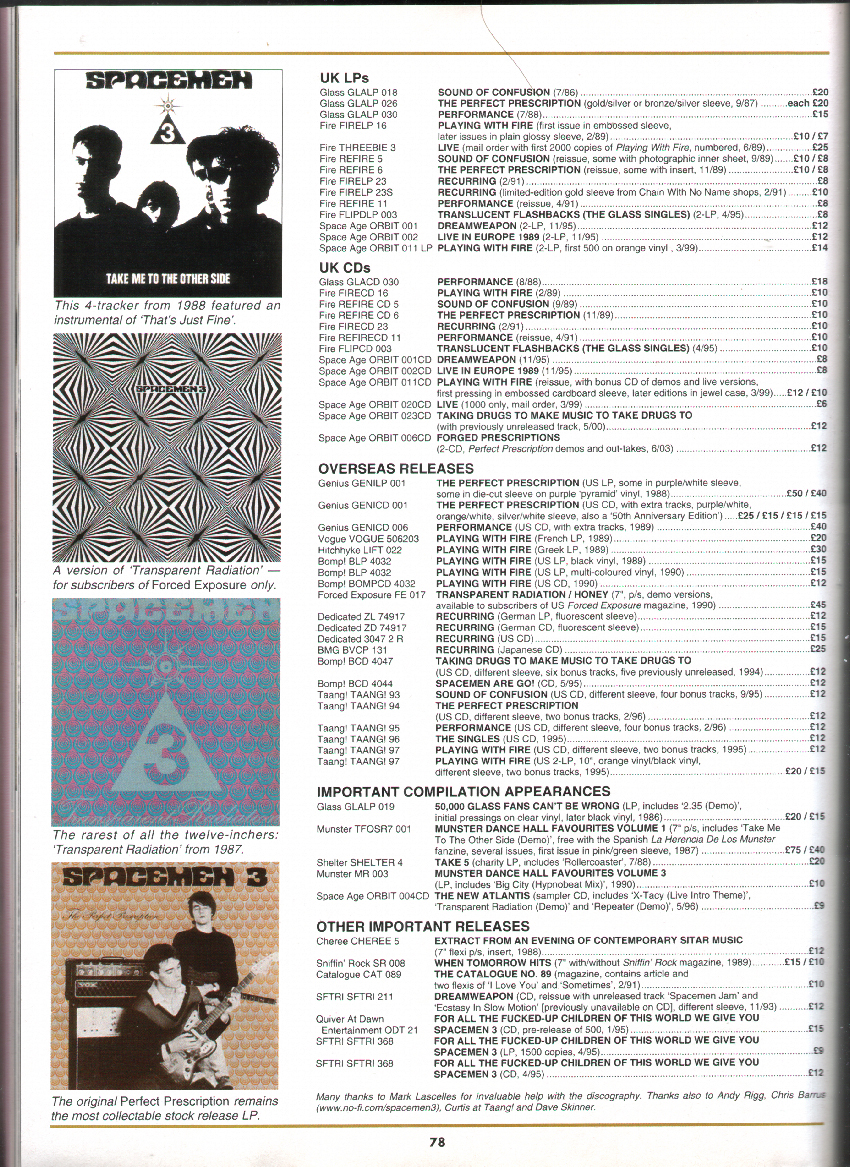This is an article I wrote for Record Collector. It was finished some time before it was published, over a year before if I recall correctly. I forgot about it, but then Forged Prescriptions came out, and with my enthusiasm refired, I dropped them an email to see if they wanted me to bring it up to date, only to discover that they were already planning to run it in the next issue and hadn’t told me about it. Cue frantic last minute re-writes, and an attempt to get Pete and Jason to do a joint photo shoot, which didn’t come off.
I had been given a word count, but I submitted way more than they had asked for. In my naivety, I thought this would be a good thing for them (more free copy!), but as someone not involved in the publishing world, I didn’t realise that this was as much of a problem as sumbitting too little. The printed version was therefore cut down. The text below is the original full version.
I have no idea why they included the word “Reunion?” on the cover. It wasn’t mentioned as a possibility in the article and they didn’t mention it anywhere else in the issue.
Stooges? Velvets? Stones?
Spacemen 3 were one of the most revolutionary UK guitar bands, whose influence is still being felt today. Ian Edmond meets Jesus at the centre of the Earth.
“Even the wretched and despised have their allotted place. Freed from all conflict we have time now to explore new concepts, new frontiers, charting the space inside our minds as we once did the outer void, with pioneers drawn from the hopelessly addicted; psychonauts prepared to risk their sanity in chemical reconnaissance of new, interior continents.
“We call them ‘spacemen.’ Every child’s ambition is to be one when they’re grown.”
Alan Moore, Miracleman #16
Spacemen 3 are principally, and it must be said unfairly, remembered for two things; that they took unreasonably large quantities of drugs, and they split very acrimoniously. Indeed, during the lifetime of this extraordinary late 80s underground band, anyone following their progress through articles in the music press could be forgiven for thinking that take drugs and argue was all that they ever did, so often was the music overlooked by scandal-hungry journalists. Recently, however, the balance has been redressed in favour of their musical achievements. May 1998 saw Rocket Girl records release “A Tribute To Spacemen 3”, with a line up that includes many of the leading lights of the contemporary space-rock scene, including Mogwai, Bardo Pond, Amp and Bowery Electric. With the band’s two (final) frontiersmen between them currently enjoying levels of critical and commercial success and producing some of the most striking sounds imaginable (via Spiritualized and Experimental Audio Research, respectively), it’s a good time to review the musical history and legacy of this most inspirational of outfits.
Spiritually, the Spacemen 3 story began on 19th November 1965, with the near-simultaneous births of Peter Kember and Jason Pierce. More conventionally, the tale goes back to the early 80s, with the first meeting of Kember and Pierce at their local Rugby art college (Kember, who would adopt aliases including The Mainliner and Peter Gunn before settling with Sonic Boom, had specifically chosen art college for the sole reason of forming a band). Pierce was already in a group called Indian Scalp, but towards the end of their studies, the two decided to form their own band. They were an ideal combination; Kember with his Cramps fixation, and Pierce with his love of The Stooges (the first record he ever bought was “Raw Power”, which he then listened to exclusively for the next year). Inevitably, considering the proximity of Rugby and Coventry, both had been teenage Ska fans.
With their heavy guitar and minimalist influences (as well as the aforementioned Cramps and Stooges, other favourites included The Velvet Underground, MC5 and Suicide), the Spacemen 3 sound finally delivered on their 1986 debut “Sound Of Confusion” comes as no surprise – a full on, fuzzed up drone of relentless guitar pounding. What is more interesting are the diversions that were taken on the way.
After effectively forming the band in Pierce’s bedroom in late 1982, and recruiting Tim Morris on drums and Pete Bain on bass (who had played together in local band Noise On Independent Street), the fledgling Spacemen played a series of infrequent gigs in the Rugby area. The band then stalled just as it had got going – Morris left to join another local band, The Push, and when Pierce went to art college in Maidstone, leaving the prospect of any further activity decidedly slim, Bain followed. Fortunately, this was only a temporary hiccup, and on Pierce’s return, things got serious. The Spacemen enlisted drummer Nicholas “Natty” Brooker, and in 1984, a demo tape was finally recorded. Showcasing a clearly embryonic band, the demo gives a fascinating glimpse into early versions of songs which would become Spacemen standards. In particular, a laid back, slide guitar take of ‘Walkin’ With Jesus’ reveals the strong blues influence which would not be revisited again as strongly until the band were all but finished. Named ‘For All The Fucked-Up Children Of This World We Give You Spacemen 3’, the demo was sold mail order and through Rugby record shop Convergence for £1. Copies are almost unknown of today, and are worth £20. An official release via Sympathy For The Record Industry surfaced in 1995, including ‘Things’ll Never Be The Same’ (recorded at the same time but omitted from the cassette) and a couple of alternate mixes.
Pete Bain rejoined the band in 1985 after the breakup of The Push, and by the end of the year, Spacemen 3 were at the top of the local scene. Come 1986, they would progress to another level. In January of that year, a second demo tape was recorded in Northampton, by which time the band’s sound had crystallised into the intense, hypnotic, overloaded psychedelia which characterised their early output, and which would serve as a template for their live act throughout their existence. It was a copy of this tape that the band gave to Pat Fish of The Jazz Butcher when he professed himself a fan after a Northampton gig. The demos aroused the interest of David Barker of Glass records, to whom The Jazz Butcher were signed, after they became a JB tour bus favourite. These demos were later released on a bootleg LP on the U.S. Father Yod label as ‘Taking Drugs To Make Music To Take Drugs To’, a title which was once in the running as the name of the first regular Spacemen album, although the sleeve incorrectly identifies the recordings as rehearsals in Rugby. A legitimate release on another U.S. label, Bomp, followed in 1994, enhanced by an alternate version of ‘2.35’, also recorded as part of the Northampton demos and later featured on the Glass compilation ‘50,000 Glass Fans Can’t Be Wrong’, and five other previously unreleased outtakes, rehearsals and live tracks.
Although Pat Fish’s experiences made him reluctant to recommend Glass, Spacemen 3 signed a two album, three year deal with the label, and immediately made plans to record their debut album proper (the stipulation that they would release an album first rather than a single being a condition of the deal). In order to keep the studio time to a minimum, the band rehearsed intensely before making the trip to Bob Lamb’s Birmingham studio. The plan had paid off – the recording and mixing of the album took a mere five days, and cost less than £800. The band found it hard working with Lamb; according to Kember, “He had no affinity with our type of music at all and was quite domineering.”
Despite this, the resulting ‘Sound Of Confusion’ album is something of an overlooked 80s psychedelic gem, if phenomenally unoriginal. Of its seven tracks, three are covers (of Stooges, Glen Campbell and Thirteenth Floor Elevators originals), while the Spacemen ‘originals’ are often heavily influenced from similar sources (most notably, ‘O.D. Catastrophe’, which bears more than a passing resemblance to The Stooge’s ‘T.V. Eye’). However, the Spacemen’s own mystery ingredient succeeds in turning what could have been a simple exercise in homage and plagiarism into something rather special. As Pierce later told Melody Maker, “We were all playing in the room, until something came through the roof, the sound we were hearing was like from some other planet or something. And that’s what Spacemen 3 was. We just found ourselves making this unearthly kind of sound that elevated us.” Using the album as a focal point for their various influences, Spacemen 3 built a platform that they, or anyone else who happened to be listening, could use as a launching pad to a multitude of destinations. The composition of the album was also largely pre-determined by the band’s decision to use it to release all of their “heavy” material, leaving the way clear for the more sedate songs that they were already writing.
The original Glass release of ‘Sound Of Confusion’ was available on vinyl only, and is now worth £25. It was reissued on vinyl, CD and cassette by Fire records in 1989, with early vinyl copies containing a photographic inner sheet. The 1995 CD only issue on the U.S. Taang label includes four extra tracks, consisting of the ‘Walkin’ With Jesus’ single and one of the ‘2.35’ demos from ‘Taking Drugs…’.
Unperturbed by the lack of attention that their debut album had mustered, Spacemen 3 chose ‘Walkin’ With Jesus’ as their first single. Attempts were made to record a version during the ‘Sound Of Confusion’ sessions, but the results were unsatisfying; consequently, the Northampton demo was dusted off and given an official release. The band returned to Carlos Morrocco’s studio where the Northampton demos were recorded to lay down extra tracks for the single, including a seventeen minute version of ‘Rollercoaster’. More than anything, this was the move that polarised the potential Spacemen fanbase into “for” and “against”, it being seen as either the ultimate adherence to their “hypnomonotony” manifesto, or a stupendous example of overindulgence. John Peel began playing ‘Rollercoaster’ on one of his radio shows, before cutting to other records, popping back after each one to comment “It’s still going!”. However, the real treat on the single turned out to be ‘Feel So Good’, a gentle two chord strum which could hardly have been more different to the aural assault it followed. There was clearly a change coming around the bend.
Early copies of ‘Walkin’ With Jesus’ came with a numbered insert which included lyrics and a minor essay on the band’s philosophy (“Spacemen 3 were born of boredom. Their music uses boredom to overcome itself.”) It’s not entirely clear how many of these were produced, but the figure is probably around 1,300.
After a change in personnel, with Stewart “Rosco” Roswell replacing Natty on drums, Spacemen 3 retreated to VHF Studios in Rugby to demo new material. The studio was looking to upgrade from 8 to 16 track, so a deal was struck – the Spacemen contributed £3,000 towards the desk in exchange for free studio time. VHF became a virtual second home to the band for the next six months, venturing out only occasionally to play a few live shows, including their first European trip. When the new material finally arrived, it was little short of a revelation.
The ‘Transparent Radiation’ EP built on the laid back atmosphere of ‘Feel So Good’, delivering two versions of the title song, the second of which in particular being a gorgeous, airy glide through sweeping violins and gentle, subtle guitars. Linking the two versions was the clearest evidence yet of the Spacemen’s unwillingness to compromise on their quest for the perfect hypnotic sound; ‘Ecstasy Symphony’ was a nine minute, electronic drone, a single note, multi tracked, phased and overlaid against itself. At once more serene and more powerful than anything they had recorded previously, the A side of the single clearly mapped out the band’s next phase. The EP’s other tracks formed a flipside in a philosophical as well as literal sense; ‘Things’ll Never Be The Same’ and the instrumental ‘Starship’ were retreads of the full-on guitar feedback of their earlier work, but with an extra, violent edge. Housed in a gorgeous pink, blue and silver sleeve, the single remains the rarest of the original Spacemen 3 issues, and today fetches £55.
‘The Perfect Prescription’ continued the journey along the blissfully sedate path which ‘Transparent Radiation’ had begun. Mirroring the surprise transition from ‘White Light/White Heat’ to ‘The Velvet Underground’, the second Spacemen 3 album all but forewent the maximum rock ‘n’ roll of their debut, bar the opening ‘Take Me To The Other Side’ and ‘Things’ll Never Be The Same’ (slightly varispeeded here from it’s appearance on the ‘Tansparent Radiation’ single). The contrast is most evident in the re-recorded ‘Walkin’ With Jesus’; previously, guitar-laden, abrasive and arrogant, now, keyboard led, sombre and resigned. Describing the realities of a certain lifestyle in a decidedly honest and unromantic fashion, the album isn’t afraid to document the moments when chemicals can enrich life almost beyond description (‘Feel So Good’ again) and threaten to take that life from you (‘Call The Doctor’). Its real beauty, as ever, is in its simplicity; as Kember told Melody Maker, “…it’s very minimal, very simple, very primal – we actually went out of our way to show that four people who couldn’t play instruments could make a sound which could be really uplifting, could turn you on, and that anyone can do that.”
‘The Perfect Prescription’ is an extraordinary record, rated by most fans as the band’s highpoint. It comes as no surprise that it has been issued more often than any other Spacemen 3 release. The original Glass vinyl was issued in two slight variations of the same sleeve design. Accompanying this was Glass’s only Spacemen 3 cassette release, bolstered by the previously released ‘Rollercoaster’, ‘Starship’ and ‘O.D. Catastrophe’; copies are now worth £20. As well as the Fire records reissue, the album has also been made available to U.S. audiences by Taang and Genius records (the latter in a plethora of sleeves and formats). All CD reissues include extra, previously available, tracks.
Rosco left the band after a particularly demanding tour of mainland Europe at the beginning of 1988, leaving the Spacemen without a full time drummer. A short U.K. tour followed, with drummers on loan from The Weather Prophets and The Perfect Disaster; shortly after, Pete Bain also quit. Down again to the essential core of Kember and Pierce, some regrouping occurred before Spacemen 3 would be seen again.
Ironically, Spacemen 3 were now receiving attention from larger independent labels. Eager to leave Glass, the band were frustrated to learn that, despite honouring the “two album” part of their contract, Glass were firmly sticking to the “three year” clause. A live recording from the European tour was offered as a contractual obligation get-out, and accepted; ‘Performance’ thus became the last Spacemen 3 album to be released by Glass (a final Glass single, a rather belated release of ‘Take Me To The Other Side’, appeared almost simultaneously, a full ten months after the album it was lifted from). Several of the participants have described the show, recorded at the Amsterdam Melkweg, to be far from the best of the tour, but it was the only show recorded on 16 track – if there had to be a live album, it was this or nothing. It must be said that if this genuinely is a substandard performance, then those attending the other gigs must have been witness to a rare treat; there is little to fault in the released concert, and the version of ‘Walkin’ With Jesus’ is sublime.
Despite the occasional live show in the preceding few months, the figurative rebirth of Spacemen 3 occurred, of all places, in the bar/foyer of an arts centre. With new bass player Will Caruthers and temporary guitarist Steve Evans, the group played a revolutionary show consisting, essentially, of a single guitar drone, held for around one and a half hours. Against this unrelenting backdrop, glimpses would emerge of melodies and themes from as-yet unreleased songs, before being re-absorbed into the pulsating centrepiece. It is unlikely that any other band would have even conceived such a performance; that Spacemen 3 were able to go through with it, despite the apparently non-plussed reaction of the people who had come to the venue for more conventional purposes (Tannoy announcements for the evening’s film presentations are clearly audible throughout) is a testimony to their purity of vision. The first record of the event was a flexi on the Cheree label, followed a couple of years later by a fuller version on Fierce (the vinyl version of which included a version of ‘Ecstasy’ which played from the label outwards!). More recent releases on Sympathy For The Record Industry and Space Age records are easy to come by.
With the release of ‘Revolution’, the first single for their new label Fire records (who had been chosen despite strong interest from Creation; indeed, the NME even reported a deal as having been done), Spacemen 3 were noticed in a big way. If it were not enough that the song itself was the most concise distillation of the heavier side of the Spacemen sound recorded up to that point, the round of accompanying interviews, outlining Kember’s shockingly frank opinions and attitudes towards drugs, were bound to attract attention. When the ‘Playing With Fire’ album arrived three months later, the band’s reputation as one of the leading innovators of the alternative scene was cemented. Reviews were overwhelmingly positive; Danny Kelly, writing in the NME, summed up the mood when he began his write up with the words “What we are dealing with here – and no other word will do – is a miracle.”
‘Playing With Fire’ manages to incorporate and further the different strands that had been spun on previous Spacemen records; as well as ‘Revolution’, the tribute to the band of the same name, ‘Suicide’, further explored hard and fast feedback and amplification, while elsewhere, tender melodies underpinned both pledges of love and pleas for redemption. The most obvious thematic divide, however, was between the songs separately authored by Kember and Pierce. The duo had contributed significantly to each other’s early work, although there had been occasional compositions which were no more joint ventures than those credited to Lennon/McCartney. The individual credits on ‘Playing With Fire’ confirmed and clarified the increasingly spiritual and gospel-influenced direction being taken by Pierce, and Kember’s predilection for purity through repetition.
Early vinyl copies of ‘Playing With Fire’ came in an embossed cover, while the first 2,000 included a voucher for a mail order only LP. Although untitled, this album has become known by its catalogue number, Threebie 3. It consists of four live tracks from the same show as ‘Performance’ (carefully omitted from the album release so as not to give Glass any songs not released up to that point), and a version of ‘Ecstasy’ that had been used as the band’s live intro tape. After production delays, it was eventually dispatched in June 1989. Original copies are now worth £25; easier to find, for the moment at least, is the recent Space Age CD only reissue, limited to 1000 copies and again available only by mail order.
Space Age have also recently reissued ‘Playing With Fire’ itself, in what must be considered the definitive version. As well as the original album and the extra tracks from the ‘Revolution’ single, this issue includes another album worth of demos, alternate versions, and a couple of unreleased covers, including ‘Any Way That You Want Me’, which would eventually see the light of day as the first release by Pierce’s band Spiritualized. The album was issued in the U.S. on Bomp and later on Taang, the latter sporting a suitably fiery interpretation of the cover artwork.
With Jon Mattock ensconced as the Spacemen’s new permanent drummer, a gruelling series of U.K. and European tours followed the release of ‘Playing With Fire’. Shortly after the recruitment of extra guitarist Mark Refoy, July saw the release of the beautiful new single, ‘Hypnotised’, which was followed by an appearance at the first re-invented Reading festival. Although no-one suspected it at the time, particularly the U.S. fans awaiting an already arranged tour, it was to be the last Spacemen 3 performance.
During the course of 1990, both Spacemen main men released solo offerings; Kember’s solo album ‘Spectrum’ was recorded with contributions from the other band members, as well as the Jazz Butcher, and Phil Parfitt and Josephine Wiggs of The Perfect Disaster, while Pierce’s debut Spiritualized single, a re-recording of ‘Any Way That You Want Me’, came as a surprise to Kember. Pierce had tired of waiting for Spacemen 3 to tour again, and organised his side project primarily for this reason. However, these factors all contributed to the general level of distrust in the band – Kember and Pierce had stopped talking to each other to any significant extent by this point – and with the release of the first Spiritualized single, Kember announced that he was leaving and that Spacemen 3 were consequently no more.
But by this time, there was already a fair amount of Spacemen 3 material taking shape (or indeed, already finished). Drawing on the same pool of musicians, Kember and Pierce recorded their tracks independently from each other, until the schizophrenic album ‘Recurring’ finally came together. Delayed again and again as mixes were perfected, ‘Recurring’ was eventually released in February 1991, trailed in January by the ‘Big City’/’Drive’ double A sided single. It is particularly ironic that ‘Big City’ saw the light of day well over a year after being recorded, as its acid house sensibilities, inspired by Kember’s glee witnessing the blissed-out audience at a Happy Mondays concert, were already dated by this point. This cannot hide the fact, however, that ‘Recurring’ is a remarkably coherent and accomplished record, embracing a wider variety of styles and influences than any other Spacemen release. Unlike ‘Playing With Fire’, no attempt was made to integrate the separate Kember and Pierce compositions, resulting in the ultimate album of two halves; side one Kember, side two Pierce. As well as further explorations of ethereal drone, especially in the feel-good haze of ‘Just To See You Smile’, Kember’s songs include the wonderful space-pop of ‘I Love You’ (heavily influenced by Bob Marley, it later transpired), strong evidence that only a small push would have been required for a major mainstream Spacemen 3 cross-over. Meanwhile, Pierce’s side saw him moving even further into blues territory with the most laid back Spacemen material to date, music so delicate and comforting that you can almost literally wrap yourself up in it for warmth.
An initial vinyl release of ‘Recurring’ from Chain With No Name shops came in a unique gold embossed sleeve, while the U.K. CD included five bonus tracks. Non-U.K. CDs (originating from Germany, Japan and the U.S.) exchange the usual album version of ‘Big City’ for the 7” version, slightly varispeed ‘Just To See You Smile’, and fade out ‘Billy Whizz / Blue 1’ almost three minutes early.
The one thing that ‘Recurring’ makes abundantly clear is that, just sometimes, the age-old adage ‘musical differences’ is not always a euphemism. Certainly, both composers display a love of the minimal, which continues to characterise both of their outputs to the present day, and yes, their personal disputes had reached such an acrimonious stage that any further collaboration was practically impossible, but by this point their writing had diverged to the extent that neither was able or prepared to accommodate the other. The quality of their respective solo material is testament to the fact that both Kember and Pierce are perfectly able to deliver the goods independently; nevertheless, their joint work remains essential, at worst intriguing, at best elevating. For those who have had their souls touched by this most striking of music, things will indeed never be the same.
Collecting Spacemen 3
There is a bewildering amount of Spacemen 3 available, a large proportion of which has materialised since the band split. All of their standard albums should be relatively easy to find; Fire have kept all of their album releases in print, as well as their re-issues of the Glass LPs. Don’t forget the bonus disk available with the Space-Age issue of ‘Playing With Fire’ – as well as being an added treat for enthusiasts, this album is an ideal starting point for the curious.
Far harder to track down are the three Glass singles, which fetch prices that reflect their rarity. Fortunately, they have been collected several times in recent years. A bootleg CD compiling ‘Walkin’ With Jesus’ and ‘Transparent Radiation’ appeared in 1993, but this has been superseded by official releases by Fire and Taang. ‘Translucent Flashbacks’, the Fire version, compiles all of the tracks from the Glass singles with the exception of ‘Things’ll Never Be The Same’, which, while being the same recording as that featured on ‘The Perfect Prescription’, is slightly varispeeded. Taang’s ‘The Singles’ includes this track at it’s correct single tempo, but edits around four minutes from ‘Rollercoaster’. Die-hards are advised to make up their own minds as to which is the greater loss. Incidentally, Glass listed a 7” of ‘Take Me To The Other Side’, but it appears that this was never carried through; certainly, no copies are known to exist.
There are many interesting foreign Spacemen 3 releases, but in the vast majority of cases, the musical content is identical to that of the U.K. versions. A notable exception is a 7” single given away to subscribers of the U.S. magazine Forced Exposure in 1990, featuring demo versions of ‘Transparent Radiation’ and ‘Honey’; these tracks remain unavailable in this form elsewhere. 25 copies, purporting to be test pressings and each with unique sleeves, have emerged since the initial batch were made available. Conversely, although they boast interesting sleeves, the Genius CDs of ‘The Perfect Prescription’ and ‘Performance’ include no exclusive material, despite splitting the ‘Walkin’ With Jesus’ b-sides ‘Rollercoaster’ and ‘Feel So Good’ across the two releases. These tracks, originally segued, have simply been faded down and up to separate them. The other extra tracks on the Genius CDs are identical to the U.K. originals.
Bootlegging has played an important part in keeping some of the rarer Spacemen material accessible, or indeed making it available for the first time. Thus, the demo of ‘Take Me To The Other Side’ featured on ‘Munster Dance Hall Favourites Volume 1’ and the stunningly rare ‘I Love You’ remix, collected on an orange vinyl 7” together with a track from a Spectrum radio session, are available to collectors unworried by the legalities of the situation for around £180 less than authentic copies would set you back. Another bootleg 7”, this time on clear vinyl, contains demo versions of ‘Come Down Easy’ and ‘Transparent Radiation’ that were originally featured on a cassette called ‘Oozing Through The Ozone Layer’, sold mail order and through Rugby record shops; the ‘Transparent Radiation’ demo has subsequently been officially issued on the Space Age compilation ‘The New Atlantis’.
Another interesting bootleg is a 7” of German origin, although it bears no label or catalogue number, coupling the Spacemen 3 version of Mudhoney’s ‘When Tomorrow Hits’ and Mudhoney’s rather disrespectful cover of ‘Revolution’. Mocked up in a Sub Pop style sleeve, and limited to 500 copies, these can now fetch £40.
The aforementioned ‘Oozing Through The Ozone Layer’ is only one of several cassettes featuring bands from the Rugby area sold locally in the 80s; others include ‘The Holy Bible’, which contains the Northampton demo of ‘Losing Touch With My Mind’, ‘Super Cosmic Joy’, a record of the event of the same name that took place on 16th May 1987, and including an unreleased live version of ‘Things’ll Never be The Same’ (as well as a 20+ minute jam by members of several bands, including the Spacemen), and ‘Breaking Down The Walls Of Heartache’, which features the then-unreleased ‘May The Circle Be Unbroken’. Many other notable bands are showcased across these cassettes, including Pulp, The Jazz Butcher, Inspiral Carpets, The Wedding Present, and several acts that would go on to have Spacemen 3 connections, such as The Tell Tale Hearts and The Cogs Of Tyme, who included Mark Refoy and Sean Cook as members, respectively. As with the original cassette version of the first Spacemen 3 demos, it is almost unknown for these tapes to be offered for sale; expect to pay around £15 for each one (if you get the chance!).
There have also been a couple of posthumous live Spacemen 3 albums. ‘Spacemen Are Go!’, issued on Bomp and later on Space Age with two extra tracks (as ‘Live In Europe 1989’) is compiled from several dates on the last Spacemen jaunt beyond the U.K. ‘Revolution Or Heroin’, released on the ever-mischievous Fierce label, is an earlier show. Although both include some interesting performances, sound quality is variable.
Many thanks to Mark Lascelles for invaluable help with the discography. Thanks also to Andy Rigg, Chris Barrus (www.no-fi.com/spacemen3), and Dave Skinner.



